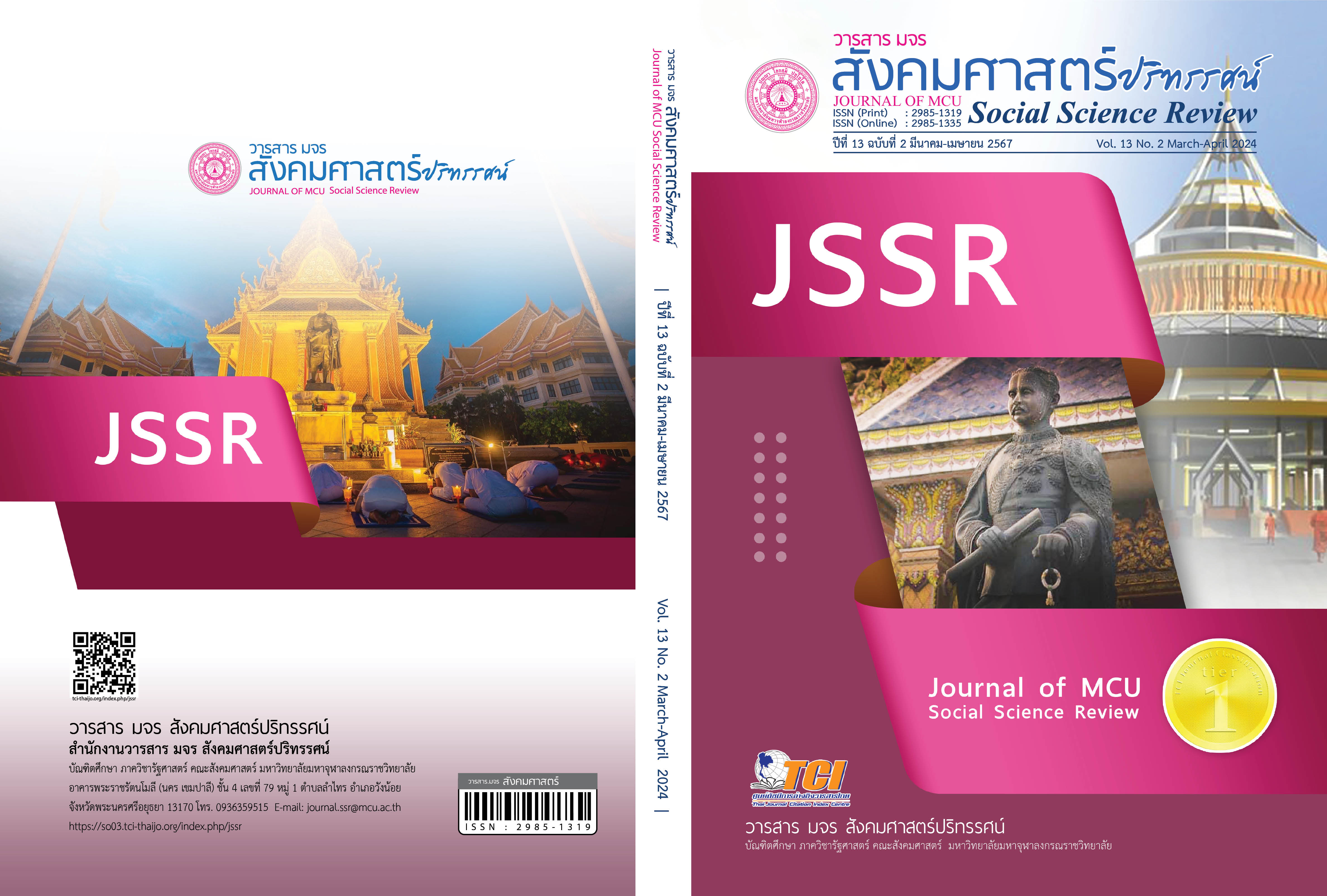การพัฒนาโมเดลเชิงตรรกะสำหรับประเมินระบบคลังข้อสอบมาตรฐาน
คำสำคัญ:
การพัฒนาโมเดลเชิงตรรกะ, ระบบคลังข้อสอบมาตรฐาน, การประเมินบทคัดย่อ
บทความวิจัยนี้มีวัตถุประสงค์ 1. พัฒนาโมเดลเชิงตรรกะสำหรับประเมินระบบคลังข้อสอบมาตรฐาน 2. ประเมินคุณภาพของโมเดลเชิงตรรกะที่พัฒนาขึ้น วิธีดำเนินการวิจัย แบ่งเป็น 2 ระยะ ได้แก่ ระยะที่ 1 การพัฒนาโมเดลเชิงตรรกะสำหรับประเมินระบบคลังข้อสอบมาตรฐาน เป็นการพัฒนาโมเดลเชิงตรรกะจากการศึกษาเอกสารและสัมภาษณ์ผู้มีส่วนได้ส่วนเสียเกี่ยวข้องกับระบบคลังข้อสอบมาตรฐานของสถาบันอุดมศึกษาตัวอย่าง จำนวน 6 คน ด้วยแบบสัมภาษณ์แบบมีโครงสร้างแบบปลายเปิด วิเคราะห์ข้อมูลโดยการวิเคราะห์เนื้อหาเพื่อสรุปเป็นองค์ประกอบของโมเดลเชิงตรรกะ จากนั้นนำโมเดลเชิงตรรกะที่พัฒนาขึ้นให้ผู้ทรงคุณวุฒิ จำนวน 5 คน ตรวจสอบความเหมาะสมเพื่อปรับปรุงโมเดลเชิงตรรกะให้สมบูรณ์ ระยะที่ 2 การประเมินคุณภาพของโมเดลเชิงตรรกะที่พัฒนาขึ้น โดยใช้แบบประเมินตามเกณฑ์มาตรฐานของคณะกรรมการประเมินทางการศึกษา ได้แก่ มาตรฐานด้านความเป็นประโยชน์ ด้านความเป็นไปได้ ด้านความเหมาะสม และด้านความถูกต้องซึ่งผู้ประเมิน ได้แก่ ผู้ทรงคุณวุฒิ จำนวน 3 คน และผู้บริหารที่มีความเกี่ยวข้องกับการใช้งานระบบคลังข้อสอบมาตรฐาน จำนวน 2 คน โดยการประเมินดังกล่าวเป็นการประเมินคุณภาพของโมเดลเชิงตรรกะหลังจากที่ได้นำไปทดลองประเมินกับผู้มีส่วนได้ส่วนเสียเกี่ยวข้องกับระบบคลังข้อสอบมาตรฐานของสถาบันอุดมศึกษาตัวอย่าง จำนวน 31 คน
ผลการวิจัยพบว่า 1. โมเดลเชิงตรรกะสำหรับการประเมินระบบคลังข้อสอบมาตรฐานที่พัฒนาขึ้นมีจำนวนองค์ประกอบที่เหมาะสมแต่ละด้านดังนี้ 1) ด้านปัจจัยนำเข้า 4 องค์ประกอบ 2) ด้านกิจกรรม 6 องค์ประกอบ 3) ด้านผลผลิต 3 องค์ประกอบ 4) ด้านผลลัพธ์ 3 องค์ประกอบ และ 5) ด้านผลกระทบ 4 องค์ประกอบ และ 2.โมเดลเชิงตรรกะที่พัฒนาขึ้นมีคุณภาพสำหรับนำไปใช้ประเมินระบบคลังข้อสอบมาตรฐาน ตามมาตรฐานการประเมินอยู่ในระดับมากทุกมาตรฐาน โดยมีคะแนนเฉลี่ยของมาตรฐาน ด้านความเป็นประโยชน์ ด้านความเป็นไปได้ด้านความเหมาะสม และด้านความถูกต้อง เท่ากับ 4.30 4.43 4.35 และ 4.42 ตามลำดับ
เอกสารอ้างอิง
กมลชนก วุฒิญาโณ และคณะ. (2563). การพัฒนาโมเดลเชิงตรรกะสำหรับประเมินกระบวนการประชาสัมพันธ์ของหน่วยงานภาครัฐแห่งหนึ่งโดยประยุกต์ใช้มาตรฐานการประเมินอภิมาน. วารสารวิธีวิทยาการวิจัย, 33(2), 167-180.
ชวนนท์ จันทร์สุข และคณะ. (2560). การพัฒนารูปแบบประเมินสมรรถนะด้านการดูแลอย่างเอื้ออาทรของนักศึกษาพยาบาล วิทยาลัยพยาบาล สังกัดสถาบันพระบรมราชชนก. วารสารการพยาบาลและการศึกษา, 10(2), 71-87.
ณพงษ์ ร่มแก้ว และคณะ. (2564). การประยุกต์ใช้ทฤษฎีการตอบสนองข้อสอบในการพัฒนาคลังข้อสอบความรู้พื้นฐานทางพลศึกษา. วารสารการวัดผลการศึกษา มหาวิทยาลัยมหาสารคาม, 27(2), 82-98.
นริสรา หร่ายพิมาย. (2560). การประเมินโครงการการจัดการเรียนการสอนแบบสะเต็มศึกษาโดยใช้โมเดลเชิงตรรกะ กรณีศึกษาโรงเรียนในเขตกรุงเทพมหานครและปริมณฑล (วิทยานิพนธ์วิทยาศาสตรมหาบัณฑิต สาขาวิชาวิทยาศาสตร์). กรุงเทพฯ: มหาวิทยาลัยศรีนครินทรวิโรฒ.
สุดารัตน์ หวลมุกดา. (2563). คลังข้อสอบ. วารสารการวัดผลการศึกษา, 26(1), 33-46.
สุรางรัตน์ ราช่อง และคณะ. (2563). การพัฒนาคลังข้อสอบความรู้พื้นฐานความเป็นครูสำหรับครูปฐมวัยด้วยทฤษฎีการตอบสนองข้อสอบ 4 พารามิเตอร์. วารสารศึกษาศาสตร์ มหาวิทยาลัยบูรพา, 31(3), 52-67.
สำนักทะเบียนและวัดผล. (2559). คู่มือการวัดและประเมินผลในระบบการศึกษาทางไกลสำหรับหลักสูตรระดับปริญญาตรี. นนทบุรี: มหาวิทยาลัยสุโขทัยธรรมาธิราช.
ศรายุทธ ปลัดกอง. (2562). การพัฒนาคลังข้อสอบการวัดทักษะการใช้โปรแกรมคอมพิวเตอร์ประยุกต์. วารสารปัญญาภิวัฒน์, 11(2), 234-243.
วรรณ์ดี แสงประทีปทอง และคณะ. (2565). รูปแบบการวัดและประเมินผลการเรียนรู้ในสถานศึกษาที่ส่งเสริมผู้เรียนให้เกิดผลลัพธ์ที่พึงประสงค์ของการศึกษาตามมาตรฐานการศึกษาของชาติ พ.ศ. 2561. วารสารศึกษาศาสตร์ มสธ., 15(1), 202-216.
Stufflebeam, D. L. (1994). Empowerment evaluation, objectives evaluation, and evaluation standards: Where the future of evaluation should not go and where it need to go. Evaluation Practice, 15(3), 321–338.
W.K. Kellogg Foundation (U.S.). (2004). Logic Model development guide. Battle Creek (MI). USA: W.K. Kellogg Foundation.
ดาวน์โหลด
เผยแพร่แล้ว
รูปแบบการอ้างอิง
ฉบับ
ประเภทบทความ
สัญญาอนุญาต
ลิขสิทธิ์ (c) 2024 วารสาร มจร สังคมศาสตร์ปริทรรศน์

อนุญาตภายใต้เงื่อนไข Creative Commons Attribution-NonCommercial-NoDerivatives 4.0 International License.
เพื่อให้เป็นไปตามกฎหมายลิขสิทธิ์ ผู้นิพนธ์ทุกท่านต้องลงลายมือชื่อในแบบฟอร์มใบมอบลิขสิทธิ์บทความให้แก่วารสารฯ พร้อมกับบทความต้นฉบับที่ได้แก้ไขครั้งสุดท้าย นอกจากนี้ ผู้นิพนธ์ทุกท่านต้องยืนยันว่าบทความต้นฉบับที่ส่งมาตีพิมพ์นั้น ได้ส่งมาตีพิมพ์เฉพาะในวารสาร มจร สังคมศาสตร์ปริทรรศน์ เพียงแห่งเดียวเท่านั้น หากมีการใช้ภาพหรือตารางหรือเนื้อหาอื่นๆ ของผู้นิพนธ์อื่นที่ปรากฏในสิ่งตีพิมพ์อื่นมาแล้ว ผู้นิพนธ์ต้องขออนุญาตเจ้าของลิขสิทธิ์ก่อน พร้อมทั้งแสดงหนังสือที่ได้รับการยินยอมต่อบรรณาธิการ ก่อนที่บทความจะได้รับการตีพิมพ์ หากไม่เป็นไปตามข้อกำหนดเบื้องต้น ทางวารสารจะถอดบทความของท่านออกโดยไม่มีข้อยกเว้นใดๆ ทั้งสิ้น





